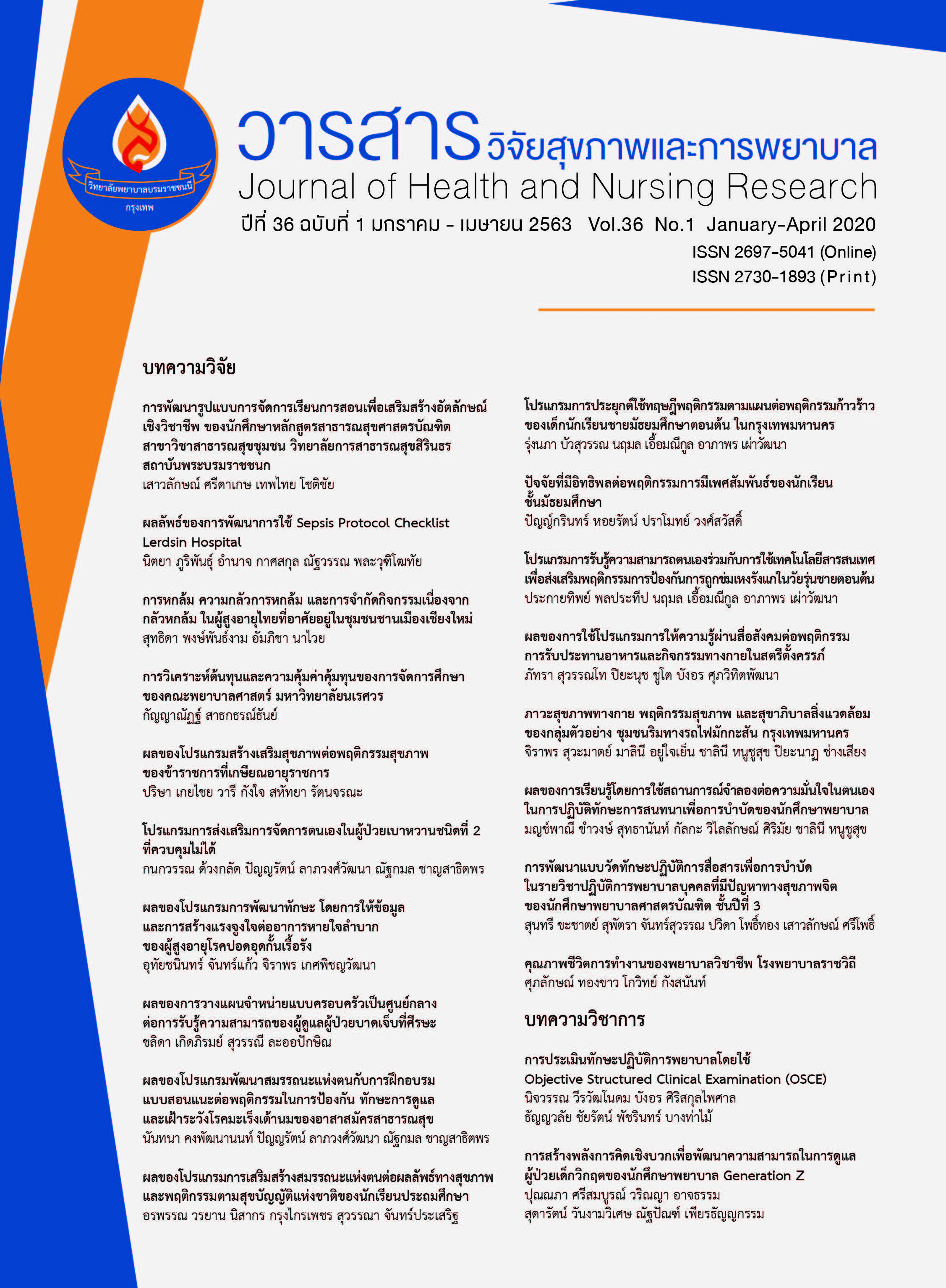การวิเคราะห์ต้นทุนและความคุ้มค่าคุ้มทุนของการจัดการศึกษา ของคณะพยาบาลศาสตร์ มหาวิทยาลัยนเรศวร
คำสำคัญ:
การวิเคราะห์ต้นทุน, ต้นทุนต่อหน่วยผลผลิต, ความคุ้มค่าคุ้มทุน, คณะพยาบาลศาสตร์บทคัดย่อ
วิจัยครั้งนี้เป็นวิจัยเชิงพรรณนา มีวัตถุประสงค์เพื่อวิเคราะห์ต้นทุนต่อหน่วยผลผลิตและศึกษาความคุ้มค่าคุ้มทุนของการจัดการศึกษาของคณะพยาบาลศาสตร์ โดยศึกษาแบบย้อนหลัง (retrospective study) จากแหล่งข้อมูลทุติยภูมิ ในการวิเคราะห์ต้นทุนต่อหน่วย จุดคุ้มทุน ต้นทุน-ผลได้ ต้นทุน-ประสิทธิผล และศึกษาประสิทธิผลของการจัดการศึกษา เครื่องมือที่ใช้เป็นแบบบันทึกต้นทุนและค่าใช้จ่าย เครื่องมือในการประเมินประสิทธิผลของการจัดการศึกษาเป็นแบบประเมินคุณภาพบัณฑิตและความพึงพอใจผู้ใช้บัณฑิตของมหาวิทยาลัยนเรศวร ตรวจความตรงตามเนื้อหา มีค่าความเชื่อมั่นเท่ากับ .95 เก็บรวมรวมข้อมูลในการวิเคราะห์ต้นทุน ตั้งแต่ปีการศึกษา 2556 ถึง 2559 ประเมินประสิทธิผลของการจัดการศึกษา โดยการเก็บรวบรวมข้อมูลจากผู้ใช้บัณฑิตในสถาบันในภาครัฐและเอกชน ที่เป็นแหล่งจ้างงานของบัณฑิตที่จบจากคณะพยาบาลศาสตร์ จำนวน 85 คน ผลการวิจัยพบว่า ต้นทุนต่อหน่วยผลผลิต 1 คนตลอดหลักสูตรเท่ากับ 413,716.14 บาท เฉลี่ยต่อปีเท่ากับ 115,900.89 บาท จุดคุ้มทุนเท่ากับ 5,792 คน และมีรายรับที่จุดคุ้มทุนเท่ากับ 186,503,237.47 บาท จุดคุ้มทุนรายปีอยู่ในช่วง 1,244 -1,541 คน รายรับอยู่ในช่วง 40,041,617.12 – 49,623,055.79 บาท ต้นทุน-ผลได้ในมุมมองผู้ผลิตในการผลิตบัณฑิตลอดหลักสูตรเท่ากับ 0.34 ต้นทุน-ประสิทธิผลตลอดหลักสูตรที่ต่ำที่สุดเท่ากับ 172,881,580.25 บาท อัตราการมีงานทำคิดเป็นร้อยละ 97.65 คุณภาพบัณฑิตเท่ากับ 3.93 คิดเป็นร้อยละ78.60 ความพึงพอใจของผู้ใช้บัณฑิตในภาพรวมเท่ากับ 3.90 คิดเป็นร้อยละ78.00 ข้อเสนอแนะในการนำไปใช้ ควรศึกษารายละเอียดของต้นทุนในแต่ละด้านเพื่อปรับลดต้นทุนหรือค่าใช้จ่ายที่ไม่จำเป็นลง ปรับเพิ่มค่าลงเบียนเพื่อลดจุดคุ้มทุน วางแผนการตลาด เพิ่มจำนวนนิสิตในแต่ละปี และปรับกลยุทธ์ในการจัดการศึกษาเพื่อให้ได้ต้นทุนที่ต่ำที่สุด
Downloads
เอกสารอ้างอิง
2. The Secretariat of the Council of Education. National education plan 2017-2036. Bangkok: The Secretariat of the Council of Education; 2017. (in Thai)
3. Usaho, C. Economic education theory: Allocation of educational resources, cost Measurement. [Internet] 2019. [cited 2019 November 25]. Available from http://gotoknow.org/blog/model18. (in Thai)
4. The Comptroller General's Department. The result of comparative analysis of unit costs of Higher education institution 2015. Bangkok: The Comptroller General's Department; 2016. (in Thai)
5. Chiang Mai University. Unit cast analysis of nursing graduates 2008. Chiang Mai: Planning Devision of Chiang Mai Uneversity; 2008. (in Thai)
6. Chiang Mai University. Unit cast analysis of nursing graduates 2009. Chiang Mai: Planning Devision of Chiang Mai Uneversity; 2009. (in Thai)
7. Narasual University. Unit cast analysis of nursing graduates 2013. Phitsanulok: Planning Devision of Narasual Uneversity; 2013. (in Thai)
8. Suntharayuth D. Economics of educational management. Bangkok: Netikul Printing Company Limited; 2010. (in Thai)
9. Milgram L, Spector A, Treger M. Understanding breakeven analysis. In managing smart Boston: Gulf Professional Publishing; 1999 p.384-385.
10. Singchangchai P. Health economics for health services. 3rd edition. Songkla: Chanmeung Printing; 2014. (in Thai)
11. Cleland VS. Mckibbin RC. The Economics of nursing. Norwalk : Appleton & Lange; 1990.
12. Drummond MF., Stoddart GL. Torrance G.W. Methods for the economic evaluation of health care programmes. Oxford : Oxford University Press; 1994.
13. Gibson JH, John MI, James HD. Orgionizations : behavior structure and processes. (4th ed.), Austin, TX: Business Publications; 1982.
14. Lanen WN, Anderson SW, Maher MW. Fundamentals of cost accounting. 4th edition. USA: McGraw-Hill Irwin; 2014.
15. Raiborn CA, Kinney MR. Cost accounting principles. 8th edition. China: China Translation & Printing Services Limited; 2011
16. The Nursing Council of Thailand. Institute certification guide for the bachelor of nursing science program. Bangkok: Judthong Company Limited; 2013. (in Thai)
17. Chumniwigkorn S. The benefits and effectiveness Analysis of investing in human capital. In Human Resource Economics 5th edition. Bangkok: Sangchan Printing Partnership; 2014. Chapter 14/p 357-392. (in Thai)
18. Singhaweratham N, Mualprasitporn R, Sawaengdee K, Jitaram P. Tasabutr W. Unit cost of nursing production and breakeven point in student production in Praboromarajchanok Institute Journal of Health Science 2018;27(5): 936 – 47. (in Thai)
19. Ministry of Finance. Government wage rate structure. Bangkok: Comptroller General's Department; 2015. (in Thai)
20. Narasual University. The report of Employment rate of graduates analysis 2014. Phitsanulok:Planning Devision of Narasual Uneversity; 2016. (In
Thai)
21. Chiang Mai University. The report of Employment rate of graduates 2017. Chiang Mai: Office of Educational Quality Development, Chiang Mai University; 2017. (In Thai)
22. Burapha University. The Employment rate of graduates 2017; [Internet] 2019. [cited 2019 November 25]. Available from https://planning.buu.ac.th/. (In Thai)
23. Prince of Songkla University. The Employment rate of graduates 2017. [Internet] 2019. [cited 2019 November 25]. Available from http://www.planning.psu.ac.th/. (In Thai)
24. Faculty of Nursing. Bachelor of Nursing Program (Curriculum update 2011). Phitsanulok: Naresuan Universiry; 2011. (In Thai)
25. Intharatus K, Yenjabok P. Art of communication: interpersonal communication. [Internet] 2004. [cited 2019 November 25]. Available from https://pirun.ku.ac.th/. (in Thai)
26. Burapha University. The satisfaction in graduate nurse of employer 2017. (Internet) 2019. (cited 2019 November 25. Available from https://planning.buu.ac.th/. (in Thai)
ดาวน์โหลด
เผยแพร่แล้ว
รูปแบบการอ้างอิง
ฉบับ
ประเภทบทความ
สัญญาอนุญาต
บทความที่ได้รับการตีพิมพ์ เป็นลิขสิทธิ์ของวารสารวิจัยสุขภาพและการพยาบาล (วิทยาลัยพยาบาลบรมราชชนนี กรุงเทพ) ไม่สามารถนำไปตีพิมพ์ซ้ำในวารสารฉบับอื่น


















